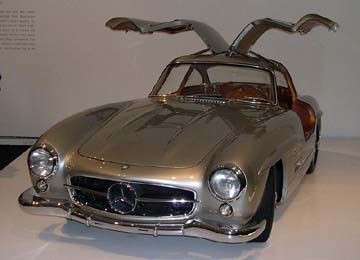

 The Accurate Reloading Forums
The Accurate Reloading Forums  THE ACCURATE RELOADING.COM FORUMS
THE ACCURATE RELOADING.COM FORUMS  Other Topics
Other Topics  Classic And Sports Cars
Classic And Sports Cars  Nice engine workshop with all the gadgets.
Nice engine workshop with all the gadgets.Go  | New  | Find  | Notify  | Tools  | Reply  |  |
| One of Us |
https://www.youtube.com/watch?v=ri_LFckaT7g Life itself is a gift. Live it up if you can. | ||
|
| One of Us |
Totally fascinating! All aluminum? I didn't see cylinder liners. I am sure that's is they Chevy does it, don't they? C.G.B. | |||
|
| One of Us |
Correction to last post, brain disconnected from fingers. 'I am sure that is the way Chevy does it, right?' C.G.B. | |||
|
| One of Us |
Maybe. Most manufacturers probably do. I'm just partial to Mercedes-Benz cars. Life itself is a gift. Live it up if you can. | |||
|
| One of Us |
What is the 'minimum' MB you have to buy to get that V8? I would guess that is not found in any of the lower end cars? C.G.B. | |||
|
| one of us |
C63. Dave | |||
|
| One of Us |
I was most impressed with the precision RTV applicator. Auburn University BS '09, DVM '17 | |||
|
| One of Us |
Nanoslide is an innovative twin-wire arc spraying technique which the company has been utilizing successfully in its 6.3-L AMG engines. It's all kind of a takeoff from the Moto Guzzi tech mostly known as nikasil. The Nanoslide technology employs the twin-wire arc spraying technique to melt and spray carbon/iron wires onto the weightless aluminium crankcase’s cylinder surfaces utilizing a gasflow to produce an ultra-fine to nano-crystalline iron coating. A unique honing process is then employed on the Nanoslide coating to give an exceptional mirror-like finish, which now has a thickness of merely 0.1-0.15 mm. | |||
|
| One of Us |
Seems like one of my Porsches had that process on the aluminum cylinders. Didn't GM try it on their Vegas? | |||
|
| One of Us |
Fascinating, thanks for the post! | |||
|
| One of Us |
Hahaha, you a funny man. | |||
|
| One of Us |
Well young feller, I guess the Vegas were before your time. You might read this and comment on it: The 2300 is a 2.3 L; 139.6 cu in (2,287 cc) inline-four engine produced by the Chevrolet division of General Motors for the 1971 to 1977 model years of the Chevrolet Vega and Chevrolet Monza. It featured a die-cast aluminum alloy cylinder block. The high-tech block features an alloy with 17 percent silicon. During the machining process, the cylinders were etched leaving the pure silicon particles exposed providing the piston wear surface, eliminating the need for iron cylinder liners. The block has cast iron main caps and a cast iron crankshaft. The engine's cylinder head is cast iron for lower cost, structural integrity and longer camshaft bearing life. The valvetrain features a direct-acting single overhead camshaft design. | |||
|
| One of Us |
Butch, I hope you did not think my post to yours was an insult. No insult intended. I was around in those days, several friends in high school had them. My comment was more to highlight the difference in how GM would do the process vs. Mercedes/AMG. Back in '85, I was sent to Dallas for 3 days, to the Mercedes headquarters, to learn about them in more detail. One example the instructor used was the Vega, and how GM made the aluminum engine vs. MB. I recall that GM used a 'fast cure' process vs. 'slow cure' for MB. Fast cure left air bubbles in the block, making the engine prone to warping when overheated, ala Vega. Slow cure allowed the air bubbles to rise in the block, and then MB would cut off the upper part of the block with all the air bubbles, leaving behind a very dense block. So, even though Gm & MB used a similar Reynolds Aluminum alloy formulation, and ran without bore sleeves, the slow cure process used by MB was quite superior for engine stability. | |||
|
| One of Us |
My comment was to show that the MB thing was not new. I did not comment about the quality of the GM blocks. As we know they weren't successful. | |||
|
| One of Us |
weren't successful? they sold what 2 million of them? everyone I knew either had one or their mom did. | |||
|
| One of Us |
Chuckle chuckle, how many are still on the road or better yet, why aren't they still produced? Only ones you see now are drag cars with big V8 engines. | |||
|
| One of Us |
well there is that. but how many other cars from that time frame are still rollin around. I ain't seen a mid 70's mustang, pacer, gremlin, Cadillac etc. since my little brother sent his fast back to the scrap heap like 20 years ago. | |||
|
| Powered by Social Strata |
| Please Wait. Your request is being processed... |
|
 The Accurate Reloading Forums
The Accurate Reloading Forums  THE ACCURATE RELOADING.COM FORUMS
THE ACCURATE RELOADING.COM FORUMS  Other Topics
Other Topics  Classic And Sports Cars
Classic And Sports Cars  Nice engine workshop with all the gadgets.
Nice engine workshop with all the gadgets.

Visit our on-line store for AR Memorabilia

